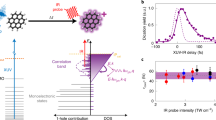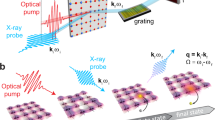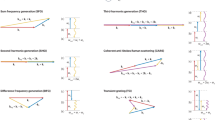Abstract
Ever since Ernest Rutherford scattered α-particles from gold foils1, collision experiments have revealed insights into atoms, nuclei and elementary particles2. In solids, many-body correlations lead to characteristic resonances3—called quasiparticles—such as excitons, dropletons4, polarons and Cooper pairs. The structure and dynamics of quasiparticles are important because they define macroscopic phenomena such as Mott insulating states, spontaneous spin- and charge-order, and high-temperature superconductivity5. However, the extremely short lifetimes of these entities6 make practical implementations of a suitable collider challenging. Here we exploit lightwave-driven charge transport7,8,9,10,11,12,13,14,15,16,17,18,19,20,21,22,23,24, the foundation of attosecond science9,10,11,12,13, to explore ultrafast quasiparticle collisions directly in the time domain: a femtosecond optical pulse creates excitonic electron–hole pairs in the layered dichalcogenide tungsten diselenide while a strong terahertz field accelerates and collides the electrons with the holes. The underlying dynamics of the wave packets, including collision, pair annihilation, quantum interference and dephasing, are detected as light emission in high-order spectral sidebands17,18,19 of the optical excitation. A full quantum theory explains our observations microscopically. This approach enables collision experiments with various complex quasiparticles and suggests a promising new way of generating sub-femtosecond pulses.
This is a preview of subscription content, access via your institution
Access options
Subscribe to this journal
Receive 51 print issues and online access
$199.00 per year
only $3.90 per issue
Buy this article
- Purchase on Springer Link
- Instant access to full article PDF
Prices may be subject to local taxes which are calculated during checkout




Similar content being viewed by others
References
Rutherford, E. The scattering of α and β particles by matter and the structure of the atom. Philos. Mag. Ser. 6 21, 669–688 (1911)
Wyatt, T. High-energy colliders and the rise of the standard model. Nature 448, 274–280 (2007)
Chemla, D. S. & Shah, J. Many-body and correlation effects in semiconductors. Nature 411, 549–557 (2001)
Almand-Hunter, A. E. et al. Quantum droplets of electrons and holes. Nature 506, 471–475 (2014)
Basov, D. N., Averitt, R. D., van der Marel, D., Dressel, M. & Haule, K. Electrodynamics of correlated electron materials. Rev. Mod. Phys. 83, 471–541 (2011)
Rossi, F. & Kuhn, T. Theory of ultrafast phenomena in photoexcited semiconductors. Rev. Mod. Phys. 74, 895–950 (2002)
Corkum, P. B. Plasma perspective on strong-field multiphoton ionization. Phys. Rev. Lett. 71, 1994–1997 (1993)
Lewenstein, M., Balcou, P., Ivanov, M. Y., L’Huillier, A. & Corkum, P. B. Theory of high-harmonic generation by low-frequency laser fields. Phys. Rev. A 49, 2117–2132 (1994)
Paul, P. M. et al. Observation of a train of attosecond pulses from high harmonic generation. Science 292, 1689–1692 (2001)
Corkum, P. B. & Krausz, F. Attosecond science. Nature Phys. 3, 381–387 (2007)
Li, W. et al. Time-resolved dynamics in N2O4 probed using high harmonic generation. Science 322, 1207–1211 (2008)
Smirnova, O. et al. High harmonic interferometry of multi-electron dynamics in molecules. Nature 460, 972–977 (2009)
Neppl, S. et al. Direct observation of electron propagation and dielectric screening on the atomic length scale. Nature 517, 342–346 (2015)
Breuer, J. & Hommelhoff, P. Laser-based acceleration of nonrelativistic electrons at a dielectric structure. Phys. Rev. Lett. 111, 134803 (2013)
Wimmer, L. et al. Terahertz control of nanotip photoemission. Nature Phys. 10, 432–436 (2014)
Nanni, E. A. et al. Terahertz-driven linear electron acceleration. Nature Commun. 6, 8486 (2015)
Kono, J. et al. Resonant terahertz optical sideband generation from confined magnetoexcitons. Phys. Rev. Lett. 79, 1758–1761 (1997)
Zaks, B., Liu, R. B. & Sherwin, M. S. Experimental observation of electron–hole recollisions. Nature 483, 580–583 (2012)
Liu, R. B. & Zhu, B. F. High-order THz-sideband generation in semiconductors. AIP Conf. Proc. 893, 1455–1456 (2007)
Ghimire, S. et al. Observation of high-order harmonic generation in a bulk crystal. Nature Phys. 7, 138–141 (2011)
Schubert, O. et al. Sub-cycle control of terahertz high-harmonic generation by dynamical Bloch oscillations. Nature Photon. 8, 119–123 (2014)
Luu, T. T. et al. Extreme ultraviolet high-harmonic spectroscopy of solids. Nature 521, 498–502 (2015)
Vampa, G. et al. Linking high-harmonics from gases and solids. Nature 522, 462–464 (2015)
Hohenleutner, M. et al. Real-time observation of interfering crystal electrons in high-harmonic generation. Nature 523, 572–575 (2015)
Shah, J. Ultrafast Spectroscopy of Semiconductors and Semiconductor Nanostructures (Springer, Berlin 1999)
Higuchi, T., Stockman, M. I. & Hommelhoff, P. Strong-field perspective on high-harmonic radiation from bulk solids. Phys. Rev. Lett. 113, 213901 (2014)
Kira, M. & Koch, S. W. Semiconductor Quantum Optics (Cambridge University Press, Cambridge, 2012)
Poellmann, C. et al. Resonant internal quantum transitions and femtosecond radiative decay of excitons in monolayer WSe2 . Nature Mater. 14, 889–893 (2015)
Xu, X., Wang, Y., Xiao, D. & Heinz, T. F. Spin and pseudospins in layered transition metal dichalcogenides. Nature Phys. 10, 343–350 (2014)
Arora, A. et al. Excitonic resonances in thin films of WSe2: from monolayer to bulk material. Nanoscale 7, 10421–10429 (2015)
Sell, A., Leitenstorfer, A. & Huber, R. Phase-locked generation and field-resolved detection of widely tunable terahertz pulses with amplitudes exceeding 100 MV/cm. Opt. Lett. 33, 2767–2769 (2008)
Gallot, G. & Grischkowsky, D. Electro-optic detection of terahertz radiation. J. Opt. Soc. Am. B 16, 1204–1212 (1999)
Kira, M. & Koch, S. W. Many-body correlations and excitonic effects in semiconductor spectroscopy. Prog. Quantum Electron. 30, 155–296 (2006)
Smith, R. P. et al. Extraction of many-body configurations from nonlinear absorption in semiconductor quantum wells. Phys. Rev. Lett. 104, 247401 (2010)
Golde, D., Kira, M., Meier, T. & Koch, S. W. Microscopic theory of the extremely nonlinear terahertz response of semiconductors. Phys. Status Solidi B 248, 863–866 (2011)
Danielson, J. R. et al. Interaction of strong single-cycle terahertz pulses with semiconductor quantum wells. Phys. Rev. Lett. 99, 237401 (2007)
Girndt, A., Jahnke, F., Knorr, A., Koch, S. W. & Chow, W. W. Multi-band Bloch equations and gain spectra of highly excited II–VI semiconductor quantum wells. Phys. Status Solidi B 202, 725–739 (1997)
Berger, C. et al. Novel type-II material systems for laser applications in the near-infrared regime. AIP Advances 5, 047105 (2015)
Ramasubramaniam, A. Large excitonic effects in monolayers of molybdenum and tungsten dichalcogenides. Phys. Rev. B 86, 115409 (2012)
Yan, J.-Y. Theory of excitonic high-order sideband generation in semiconductors under a strong terahertz field. Phys. Rev. B 78, 075204 (2008)
Vu, Q. T. et al. Light-induced gaps in semiconductor band-to-band transitions. Phys. Rev. Lett. 92, 217403 (2004)
Vampa, G. et al. Theoretical analysis of high-harmonic generation in solids. Phys. Rev. Lett. 113, 073901 (2014)
Banks, H. et al. Terahertz electron-hole recollisions in GaAs/AlGaAs quantum wells: robustness to scattering by optical phonons and thermal fluctuations. Phys. Rev. Lett. 111, 267402 (2013)
Wang, H. et al. Transient nonlinear optical response from excitation induced dephasing in GaAs. Phys. Rev. Lett. 71, 1261–1264 (1993)
Peyghambarian, N. et al. Blue shift of the exciton resonance due to exciton-exciton interactions in a multiple-quantum-well structure. Phys. Rev. Lett. 53, 2433–2436 (1984)
Beal, A. R. & Liang, W. L. Excitons in 2H-WSe2 and 3R-WS2 . J. Phys. C 9, 2459–2466 (1976)
Mitioglu, A. A. et al. Optical investigation of monolayer and bulk tungsten diselenide (WSe2) in high magnetic fields. Nano Lett. 15, 4387–4392 (2015)
Acknowledgements
We thank H. Banks for critical reading of the manuscript. The work in Regensburg was supported by the European Research Council through grant number 305003 (QUANTUMsubCYCLE) and the Deutsche Forschungsgemeinschaft (through grant number HU 1598/2-1 and GRK 1570), and the work in Marburg by the Deutsche Forschungsgemeinschaft (through SFB 1083, SPP 1840 and grant numbers KI 917/2-2, KI 917/3-1). The work in Santa Barbara was supported by the National Science Foundation (through grant number DMR 1405964).
Author information
Authors and Affiliations
Contributions
F.L., M.H., M.S.S., U.H., M.K. and R.H. conceived the study. F.L., M.H., C.P.S. and R.H. carried out the experiment and analysed the data. C.P., P.N., T.K. and C.S. provided, processed and characterized the samples. U.H., J.T.S., S.W.K. and M.K. developed the quantum-mechanical model and carried out the computations. All authors discussed the results and contributed to the writing of the manuscript.
Corresponding authors
Ethics declarations
Competing interests
The authors declare no competing financial interests.
Extended data figures and tables
Extended Data Figure 1 Polarization of high-order sidebands.
a, b, False-colour plot of the spectral intensity of high-order sidebands (generated under resonant, spectrally narrow, optical excitation) of orders two to eight as a function of their polarization for horizontal (a) and vertical (b) polarization of the interband excitation pulse. The polarization angle is defined such that 0° corresponds to a horizontally polarized excitation. c, Spectrally integrated sideband intensity as a function of the polarization angle.
Extended Data Figure 2 Pump-fluence dependence of time-resolved high-order sideband generation.
a, The measured high-order sideband intensity IHSG (spectrally and temporally integrated, red spheres) scales linearly with the pump fluence Φ, as indicated by a guide to the eye (black dashed line). b, The modulation depth of the spectrally integrated temporal trace of IHSG (red spheres, see Fig. 2b) decreases with increasing pump fluence, closely following a fit (black curve) proportional to the inverse square-root of the pump fluence. c, By contrast, the relative subcycle delay δscT−1 does not substantially change with increasing pump fluence. Red spheres represent the average of δscT−1 over the nine dominant, consecutive, high-order sideband peaks (see Fig. 2d) for different pump fluences; error bars indicate their standard deviation. The black dashed line marks the mean value of the displayed data points.
Extended Data Figure 3 Coherent excitonic polarization dynamics in k space.
a, Computed high-order sideband intensity IHSG (red shaded area) and driving waveform (blue). Vertical black dotted lines highlight characteristic delay times tex at extrema of IHSG. b–d, Coherent interband polarization |p|2 (colour scale) as a function of time t and reciprocal space coordinate k (in units of the wave vector kBZ limiting the first Brillouin zone) for distinct delay times tex according to maximum (b, tex = 7 fs; d, tex = 28 fs) and minimum (c, tex = 18 fs) HSG emission. Horizontal white lines mark k = 0. The driving field is depicted as grey curves and the recollision times (see Fig. 3d) are highlighted by black arrows.
Extended Data Figure 4 Influence of dephasing on high-order sideband generation.
a, b, The measured sideband spectrum (shaded area) is compared with computations using constant dephasing times of T2 = 3.2 fs (a, red curve), T2 = 4 fs (b, blue curve) and a momentum-dependent dephasing model as presented in Fig. 1 (black curves; EID, excitation-induced dephasing). The sideband orders n are indicated above the relevant peaks. All spectra are normalized to the sideband peak corresponding to n = 2. The inset in a depicts the corresponding dephasing times T2(k) as a function of the wave vector k; the red (blue) horizontal line indicates a constant decay level T2 = 3.2 fs (T2 = 4 fs).
Extended Data Figure 5 Field scaling of time-resolved high-order sideband generation.
a, Scaling of the modulation depth (see discussion in Methods section ‘Influence of excitation fluence’) of temporal traces of high-order sideband intensity with the driving peak field strength. An increase in the modulation depth suggests a faster dephasing T2. b, Subcycle delay δsc in units of the driving period T averaged over the eight most-dominant sideband peaks as a function of the peak field. The error bars represent the standard deviation of the eight peaks and the dashed line depicts a linear fit to the data points.
Extended Data Figure 6 Influence of excitation-induced dephasing.
a, Terahertz waveform used in the computations. b, c, Mean electron excursion  calculated with a constant dephasing T2 = 12 fs (b) and excitation-induced dephasing (c) for a delay of tex = 7 fs (see vertical dotted lines in a). The shaded areas indicate the intensity envelopes of the excitation pulse with a full-width at half-maximum of 10 fs (yellow) and 100 fs (grey). The corresponding mean momenta
calculated with a constant dephasing T2 = 12 fs (b) and excitation-induced dephasing (c) for a delay of tex = 7 fs (see vertical dotted lines in a). The shaded areas indicate the intensity envelopes of the excitation pulse with a full-width at half-maximum of 10 fs (yellow) and 100 fs (grey). The corresponding mean momenta  are shown as red and black curves, respectively. The red dashed curves show
are shown as red and black curves, respectively. The red dashed curves show  after the electron–hole collision. The dashed horizontal lines in c mark the positions in k space where the scattering time T2(k) switches from slow to fast dephasing.
after the electron–hole collision. The dashed horizontal lines in c mark the positions in k space where the scattering time T2(k) switches from slow to fast dephasing.
Extended Data Figure 7 High-order harmonic generation in tungsten diselenide.
An intensity spectrum (blue shaded area) of THz-driven high-order harmonic generation in 60-nm-thick WSe2 shows distinct peaks at odd orders n′ = 13 to n′ = 47 (indicated by numerals) of the fundamental frequency νTHz = 22.3 THz (peak electric field in air, 21 MV cm−1; φ = 90°). An intensity spectrum for φ = 120° is also shown as a black curve. The spectral intensity has been corrected for the grating efficiency and for the quantum efficiency of the spectrograph used.
Extended Data Figure 8 Differential sideband spectroscopy.
a, b, Contours of differential spectra ΔI(ν, νopt) (colour scale) as a function of h(ν − ν2SB) and detuning Δopt computed for an excitonic binding energy of EB = 60 meV (a) and EB = 600 meV (b). The black and grey vertical lines mark the positions of the slices shown in c and d, respectively. c, d, Snapshots of ΔI(ν, νopt) at fixed values of |h(ν − ν2SB)| = 16 meV below (c) and above (d) the second-order sideband peak for three different binding energies EB = 60 meV (black curves), EB = 240 meV (red curves) and EB = 600 meV (blue curves).
Extended Data Figure 9 Quantitative analysis of the binding energy.
a, Measured differential spectra ΔI(ν, νopt) for three different detunings Δopt = −75 meV (shaded area), Δopt = −29 meV (black curve) and Δopt = 27 meV (red curve) as functions of ν, centred at the position of the second sideband ν2SB. b, d, f, Computed differential spectra ΔI(ν, νopt) for binding energies of EB = 60 meV (b), EB = 240 meV (d) and EB = 600 meV (f) and detunings Δopt as in the experiment shown in a. c, e, Measured (c) and calculated (e) HSG intensities (colour scale) for Δopt = 0 as functions of νHSG and delay tex.
Rights and permissions
About this article
Cite this article
Langer, F., Hohenleutner, M., Schmid, C. et al. Lightwave-driven quasiparticle collisions on a subcycle timescale. Nature 533, 225–229 (2016). https://doi.org/10.1038/nature17958
Received:
Accepted:
Published:
Issue Date:
DOI: https://doi.org/10.1038/nature17958
This article is cited by
-
Attosecond electron microscopy by free-electron homodyne detection
Nature Photonics (2024)
-
Lightwave electronics in condensed matter
Nature Reviews Materials (2023)
-
Emerging ultrafast techniques for studying quantum materials
Nature Reviews Materials (2023)
-
Orbital perspective on high-harmonic generation from solids
Nature Communications (2023)
-
High-harmonic generation in CdTe with ultra-low pump intensity and high photon flux
Communications Physics (2023)
Comments
By submitting a comment you agree to abide by our Terms and Community Guidelines. If you find something abusive or that does not comply with our terms or guidelines please flag it as inappropriate.



